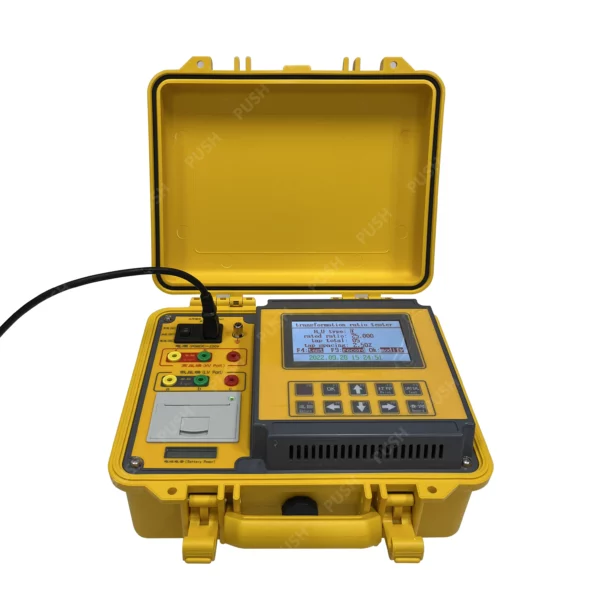How does temperature affect the accuracy of turns ratio measurements?
Temperature can significantly impact the accuracy of turns ratio measurements in transformer testing due to the effects it has on the electrical properties of materials and the performance of the testing equipment:
- Changes in Material Properties: Temperature variations can alter the electrical properties of transformer windings and materials, affecting their impedance and conductivity. This can lead to variations in the magnetic and electrical characteristics that the turns ratio tester measures.
- Temperature Coefficients: Some materials used in transformers exhibit temperature-dependent changes in their properties. For instance, the permeability of the core material may vary with temperature, affecting the magnetic field and inductance, thereby influencing the turns ratio.
- Calibration Drift: Components within the turns ratio tester, such as electronic circuits or sensors, can be sensitive to temperature changes. This sensitivity might cause the tester’s calibration to drift, impacting the accuracy of measurements.
- Thermal Expansion and Contraction: Temperature changes can cause physical expansion or contraction of transformer components, affecting the winding geometry and potentially altering the turns ratio.
- Insulation Properties: Variations in temperature can impact the insulation properties of the transformer windings. Changes in insulation resistance or dielectric strength can affect the flow of currents during testing, leading to inaccurate measurements.
- Testing Environment: The temperature of the testing environment itself can affect the accuracy of the measurements. Fluctuations in the ambient temperature might indirectly impact the temperature of the transformer under test.
To mitigate temperature-related inaccuracies in turns ratio measurements:
- Perform tests in a controlled environment with stable temperatures.
- Allow the transformer to reach thermal equilibrium before testing.
- Account for temperature variations by applying correction factors or compensations based on temperature coefficients of the materials involved.
- Calibrate the turns ratio tester regularly to account for any drift caused by temperature or other factors.
Understanding and compensating for temperature effects are crucial for obtaining accurate and reliable turns ratio measurements, turns ratio tester particularly in situations where temperature variations are significant or unavoidable.
How does a turns ratio tester handle different voltage and power ratings of transformers?
A turns ratio tester is designed to accommodate various voltage and power ratings of transformers by offering flexibility in its measurement capabilities and ensuring safety during testing.
Here’s how it handles different voltage and power ratings:
- Voltage Range: Turns ratio testers come with adjustable voltage ranges to cater to different transformer ratings. They can typically handle low-voltage transformers found in small appliances as well as high-voltage transformers used in power distribution systems.
- Voltage Transformation: The tester applies a low-voltage signal to the primary winding and measures the resulting voltages on the secondary windings. It adjusts for varying ratios, allowing measurements for transformers with different turns ratios.
- Power Ratings: Turns ratio testers are designed to be compatible with transformers of varying power ratings. They can handle both small-sized transformers used in electronics and larger power transformers used in utility-scale applications.
- Safety Features: To ensure safety during testing, turns ratio testers often incorporate features such as overload protection, insulation monitoring, and grounding provisions. These safety measures prevent damage to the tester and ensure operator safety, irrespective of the transformer’s power rating.
- Accuracy and Precision: The tester’s accuracy is maintained across different voltage and power ratings through calibration and verification procedures. Calibration routines and verification checks are crucial to ensure reliable measurements across a wide range of transformers.
- Interface and Controls: The user interface of turns ratio testers is designed to be user-friendly, allowing operators to input transformer specifications or select appropriate settings based on the transformer being tested. This adaptability streamlines the testing process for different transformer ratings.
- Compatibility: Turns ratio testers are versatile and compatible with various types of transformers, including single-phase, three-phase, auto-transformers, instrument transformers, and more.
- Adaptable Test Methods: These testers often support different test methods and techniques to suit the characteristics of transformers with different voltage and power ratings, ensuring accurate and reliable measurements.
By providing a broad range of voltage capabilities, safety features, adaptable test methods, and accuracy across different power ratings, turns ratio testers offer versatility and reliability in measuring turns ratios for various types and sizes of transformers.

